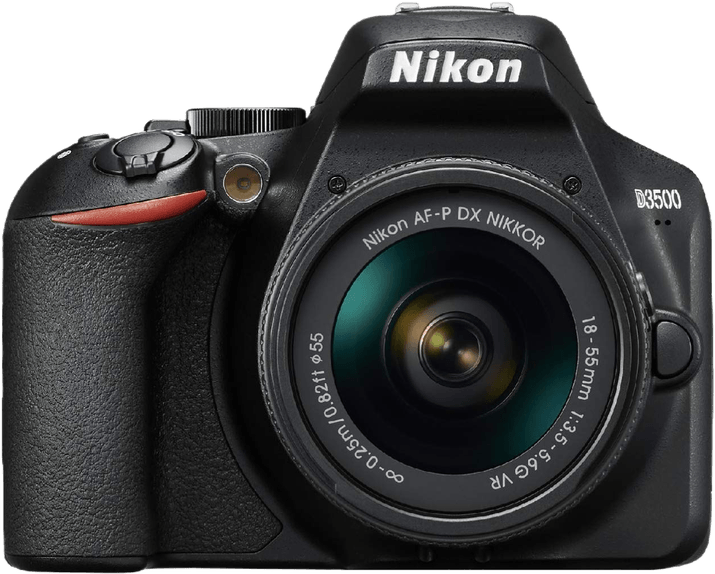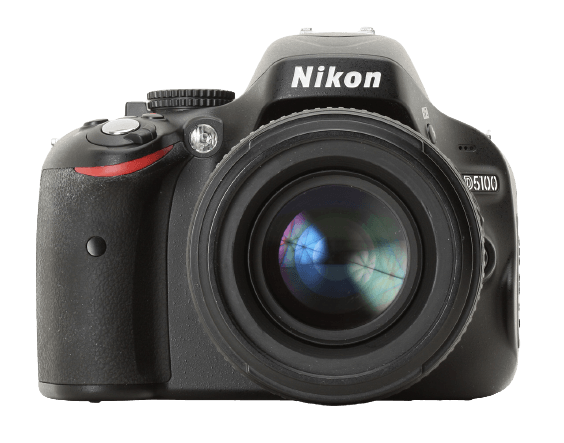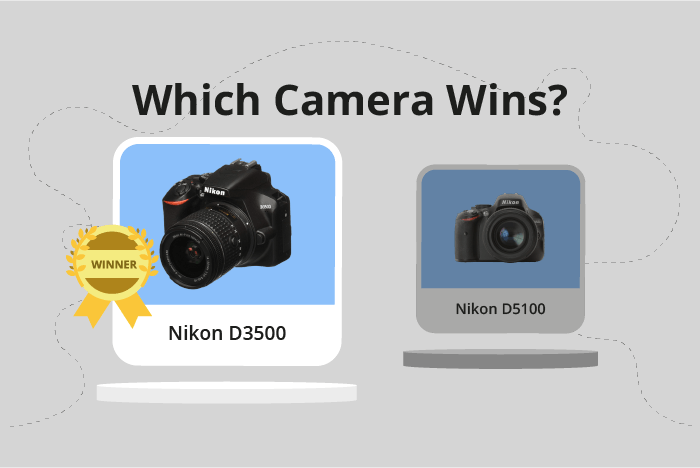Nikon D3500 vs D5100 Comparison
Nikon D3500

Nikon D5100

The Nikon D3500 emerges as the winner with a score of 61/100, while the Nikon D5100 trails behind at 49/100. Both cameras share similarities as DSLR cameras, released in 2018 and 2011 respectively, with the D3500 being priced at $499.95 and the D5100 at $799. They have similar dimensions, with the D3500 measuring 124 x 97 x 70mm and the D5100 at 128 x 97 x 79mm.
The D3500 outperforms the D5100 with its higher score, reflecting its better overall quality. However, the D5100 has a slight advantage in weight, being lighter at 560g compared to the D3500’s 615g.
Taking into account their scores, specifications, and prices, the Nikon D3500 proves to be a better camera choice than the Nikon D5100. The D5100’s only advantage is its lighter weight, but this does not outweigh the superior performance of the D3500.
Nikon D3500 vs D5100 Overview and Optics
The Nikon D3500 outperforms the Nikon D5100 in optics with a score of 65/100 compared to the D5100’s 52/100. Both cameras share common specifications such as CMOS sensor type, APS-C sensor size, Nikon F lens mount, and the absence of image stabilization.
The D3500 takes the lead with its higher megapixel count of 24, allowing for greater image resolution and detail. Additionally, the D3500 boasts a faster shooting speed of 5 frames per second, enabling users to capture fast-moving subjects more effectively. The camera’s Expeed 4 processor also contributes to its superior performance, resulting in faster image processing and improved noise reduction. Furthermore, the D3500’s DXOMARK sensor score of 87 demonstrates its ability to produce high-quality images with a wider dynamic range and better low-light performance.
On the other hand, the D5100 has a lower megapixel count of 16.2, which may suffice for casual photographers but may not be suitable for those seeking higher image resolution. Its shooting speed of 4 frames per second is also slower than the D3500, potentially limiting its ability to capture fast action shots. The D5100’s Expeed 2 processor may hinder its performance in terms of image processing and noise reduction. Its DXOMARK sensor score of 80, although respectable, falls short compared to the D3500’s score.
Taking these factors into consideration, the Nikon D3500’s superior optics make it the better choice for photographers prioritizing image quality, resolution, and speed. Although the D5100 may be adequate for casual use, the D3500 outshines it in terms of overall optical performance.
Nikon D3500 vs D5100 Video Performance
The Nikon D5100 has a narrow lead in video performance. Both cameras allows users to record videos in Full HD, with a maximum resolution of 1920 x 1080.
The highest video frame rate available for the D5100 is 30 frames per second. On the other hand, the Nikon D3500 supports a maximum video frame rate of 60fps, providing smooth and clear footage. However, the Nikon D3500 does not have built-in time-lapse functionality, giving the D5100 an edge.
Nikon D3500 vs D5100 Features and Benefits
The Nikon D3500 emerges as the winner in this comparison, with a feature score of 54 points, compared to the Nikon D5100’s 41 points. Both cameras share certain specifications, including a 3-inch screen size and the lack of a touchscreen, GPS, and WiFi connectivity. However, the D3500 outperforms the D5100 in some areas, while the D5100 has its own advantages.
The Nikon D3500 has a slightly higher screen resolution at 921,600 dots, as opposed to the D5100’s 921,000 dots. This difference makes the D3500’s display marginally sharper and clearer. Additionally, the D3500 includes Bluetooth connectivity, allowing for seamless pairing with compatible devices for easy file transfers and remote control operation.
On the other hand, the Nikon D5100 possesses a flip screen, which the D3500 lacks. This feature enables users to capture images and videos from various angles, making it particularly useful for shooting in tight spaces or capturing self-portraits. However, the D5100 does not have Bluetooth connectivity, limiting its compatibility with other devices.
In light of these differences, the Nikon D3500 offers a better overall feature set, with a higher screen resolution and Bluetooth connectivity. The D5100’s flip screen may appeal to some users, but its lack of Bluetooth and lower feature score make it less competitive overall. Consequently, the D3500 is the more attractive option for photographers seeking a combination of essential features and modern connectivity options.
Nikon D3500 vs D5100 Storage and Battery
The Nikon D5100 outperforms the Nikon D3500 in storage and battery with a score of 51/100 compared to the D3500’s 48/100. Both cameras share common specifications in storage, having one memory card slot each and accepting SD, SDHC, and SDXC memory cards. Neither camera offers USB charging.
The D5100’s advantage lies in its longer battery life, providing 2200 shots compared to the D3500’s 1550 shots. This difference allows for more extended shooting sessions without needing to change batteries. However, the D3500 uses the newer EN-EL14a battery type while the D5100 uses the older EN-EL14.
Although the D3500 has a shorter battery life, its newer battery type may offer better performance in certain situations. Ultimately, the choice between the two cameras depends on the user’s needs and preferences. The D5100 is better for longer shooting sessions, while the D3500 has a more modern battery type.
Alternatives to the Nikon D3500 and D5100
Are you still undecided about which camera is right for you? Have a look at these popular comparisons that feature the Nikon D3500 or the Nikon D5100:

